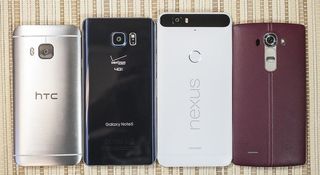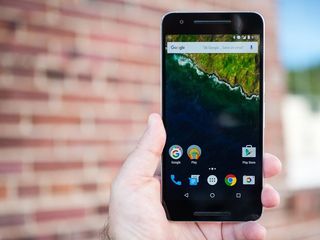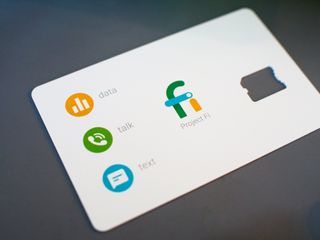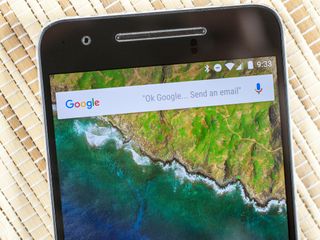When we started our series of "second opinion" reviews, the idea was simple. Good reviews are a mix of the objective and subjective, and we all have different ideas about what makes a good smartphone good. Maybe one reviewer will spot something another didn't. Maybe one is inherently biased in one direction or another.
Second opinions are important, and unfortunately nobody else on the Internet is reviewing smartphones these days. (Ed. note: I've been told that's technically no longer true. Go figure.)
This Nexus 6P second opinion will not be one of those dissenting reviews. Jerry unabashedly gushed over the phone in our official take on the phone — "It's the best Android phone I've ever used," he wrote.
I've been using the Nexus 6P full-time for nearly a month now, and I think he's right. Here's why.

First, a little background ...
Early on in 2015 I made a conscious decision: No more compromises when it comes to camera quality. I spent many months before with phones from HTC and Motorola in my pockets, products I very much enjoyed from companies I know and love. The cameras were serviceable, but not great, and more often than not I'd process photos within an inch of their life so that they looked more artsy than bad.
My mission in 2015: No more compromises on cameras.
I wasn't going to put up with that this year. That really left me with just a couple choices: LG, and Samsung. As I'd all but shunned the Galaxy line the past few years — it's just not my thing — it was time for another change. I was going to use the Galaxy S6, come hell or high water. And the GS6 is one hell of a phone. But the poor battery life was a deal-breaker. The Galaxy Note 5 served me much better — surprisingly, actually, because previous versions of that phone were just too damned big for me.
The LG G4 still is a great design, with a great camera and good battery life. But the software was pretty janky this year. It's gotten better, but I've moved on. (I'm plenty excited about the LG V10, though, and have high hopes for the LG G5 in 2016.
That all serves as context for where I'm at today, with the Nexus 6P — the first Nexus phone from Chinese manufacturer Huawei — never leaving my side.
The hardware
A confession. Or, perhaps, a resignation. I'm now fine with large phones. I got used to the Galaxy Note 5 just fine. I've used the blunt-instrument that is the LG V10 without issue. And I've had no issue with the size of the Nexus 6P. Oh, maybe it feels a little big in the pocket. Fine. And maybe it doesn't quite fit neatly in the cupholder of my venerable old Honda Civic.
That's not to say all large phones are created equal. I still contend the design of the 2014 Motorola Nexus 6 causes it to feel bigger than it is — and it's already more than 3.6 mm wider than the LG V10, and more then 5 mm wider than the Nexus 6P. That makes a big difference in feel.

I've got no complaints about the display. I tend to not get too caught up in the nuances of color temperature, but I do know a good display (anything Samsung, really) from a not-so-good one (what HTC used in the M9 this year). The AMOLED panel in the 6P is just fine, as is the QHD resolution. I guess I could live without the faux-Active Display feature — where new notifications will flash in a battery-sipping light white without having to wake the phone. That's just much more useful in something like the Moto X when you can wave your hand over it to activate. It's close, but not the same.
And I've no real complaints about the body of the phone, either. The chamfered edges — a throwback to the 2013 HTC One M7 if you think about it — look as good as they ever have. I'm a fan of those. They're especially striking in the "frost" white color of the phone, but also nice in the aluminum.
I like bigger phones. There. I said it. Or, rather, I like big phones done right.
It's nice having front-facing stereo speakers again. They're pretty good. Maybe not quite as deep as what you get from HTC's M series, but it's close enough for my purposes. It's certainly better than the other phones I've spent time with this year — LG's G4 and V10, and especially the GS6 and to a lesser extent the Note 5.
We've had some internal debate over whether the "frost" white model feels cheaper than the brushed aluminum variant, even though it looks better, and I'm inclined to agree. We've also seen a little bit of variance in the fit of the phone. Mating plastic with metal is never easy — every single one of the half-dozen M7s I used (and few M8s) had annoying little differences in the way the SIM tray or plastic spacers fit, and we've seen a little bit of that in the Nexus 6P. That's not out of the ordinary on early runs of devices, but it's something to look out for. (It's also not keeping me up at night.)
The top third of the rear of the 6P is kind of exciting. The black band on the hump is an excellent contrast to the white body, and the thickness of the hump is perfect, as much a design feature as it is a necessity.

This is fingerprint recognition the way it should be — now we just need more apps.
And the fingerprint scanner is everything you'll want for one that's on the back of the phone. It's perfectly positioned for your index finger — even if it's on the stubby side — and is the only way I wake and unlock the phone now. In fact, I no longer use Smart Lock connected to an Android Wear watch to bypass the lock screen. The fingerprint scanner and unlock is that good, and I'm about 95 percent successful in unlocking the phone on the first try.
Now we just need more applications to take advantage of the fingerprint APIs.
USB-C has taken a little getting used to — mostly because I need to make sure I've got enough new cables stashed places. My home. My office. My car. My wife's car. The biggest change has be the unknowns. There are microUSB plugs all over the place. But if I don't have an adapter on me, I'm SOL. And I'm not going to walk around with an adapter on me. But all things being equal I'm pretty happy with USB-C as a plug, though I still catch myself looking to make sure I'm putting it in the right way. That'll get better as more phones launch with USB-C.
All in all, the Nexus 6P is what our British friends would call a great piece of kit. It absolutely takes some cues (ahem) from phones before it, but the execution is damned good, especially considering that it starts at $499 and with the proper amount of storage — 32 gigabytes. This is the metal phone folks have been waiting for all year.





The software: Android 6.0 Marshmallow
Plenty has been said about Android 6.0 Marshmallow — read our full Android 6.0 review for more — so I'm not going to dive too deep into that. It's probably not too incorrect to view M as a "fixed" version of L, and I can live with that.
And that's not to say I hate on principle what manufacturers tend to do with Android. HTC's due for a Sense revamp, I guess (and what it did with the A9 was interesting), Samsung's gotten more usable, and LG is getting better every year. It's all usable, and I end up customizing things the way I want anyway, specifically with a new launcher.
One of the most important places where I think "stock" Android continues to get things right is when the notification shade and the quick settings. Too many manufacturers continue to combine the two, leaving precious little room for notifications. That's not quite a crime against humanity, but it's pretty unforgivable at this point in time. And it's a feature that Google has nailed. It's a small thing, maybe, but one that you'll use many times a day.

Stock Android is the only place you'll find notifications and quick settings done right.
Beyond that, it's the APIs that excite me. We're still really early into the fingerprint thing. Password apps will use it. Android Pay uses it well. More will come. And it's great to see this finally built in to Android itself.
It's worth noting (after a lot of griping the past year) that Google has fixed its sound and notification scheme. No more worrying about whether an alarm will actually fire off — it will. I'd like Android to maybe suggest turning on the automatic Do Not Disturb mode the first night or two — like what Motorola does — but then again I'm also fine just manually silencing the phone at the end of the night with the volume key.
Mostly, for my purposes, "stock" Marshmallow cleans things up in the UI/UX department, and that's a big thing. It'll be interesting to see how manufacturers muck it up in 2016. For now, though, I'm very content.
But here's the most important part, and it's one we're putting more emphasis on going forward: The software will be updated. It will be updated often, and it will be updated in a timely manner. Other phones may well improve in this department (there's not much room to get worse), but Nexus sets the gold standard when it comes to Android software updates.

Consider Project Fi for the Nexus 6P
If you really want to go all in with the Nexus 6P, it's worth taking a look at Google's Project Fi service. The short version is that it uses T-Mobile or Sprint service, depending on which is working best where you are. Plus it'll help you automatically connect to open Wifi spots and then run everything through a secure VPN.
It's not necessarily the cheapest option, but it does compete. But more important is that it's probably the easiest experience we've had in the U.S. when it comes to mobile service.
Click here to learn more about Project Fi!
Nexus 6P camera
What could I say about the Nexus 6P camera that hasn't been said already? We finally have a Nexus phone with a camera that doesn't make you want to carry a second device with you. It's not the best one you can get — I'd still give that title to this year's Samsung phones or the LG G4 and V10. But for basic social sharing, the Nexus 6P is more than good enough.
The only low point for me is Google's camera app. It's continuously improved, but it's just not as good as what Samsung and LG are doing. HDR feels a little off to me, but that's definitely a subjective thing. A good many third-party camera apps have been a little broken with all the API changes, so I've held off on switching to anything else yet, and Google's app is plenty functional. I just think the manufacturer apps are easier to use. (And I'd love to see Google add some RAW options.)
The proof is in the pudding, of course. So with that, some samples.




















The bottom line
The best Nexus? By far. And that's not just because it's another phone in another year and hardware and software tend to get better over time. That's certainly true. But this is the first year in which everything has come together as it should.
The software works. And it works well. And it will be updated.
The hardware is solid. We'll have to see how it holds up long-term — I'm a little worried about scratches on the rear glass panel. But for me this is the best metal phone, the best Nexus ... nay the best phone ... we've seen in quite some time.

Huawei calls landing a nexus 'a dream'
The Nexus 6P is Huawei's first real push into the U.S. market, as well as its first time manufacturing Google's flagship phone.
"It's always been a dream for Huawei to work with Google for the Nexus 6P," Huawei VP of research and development Eric Fang told us and other journalists recently in Beijing. Fang went on to describe how the Nexus 6P was one of the most challenging products he's worked on in his career.
Click here to read the full interview!

